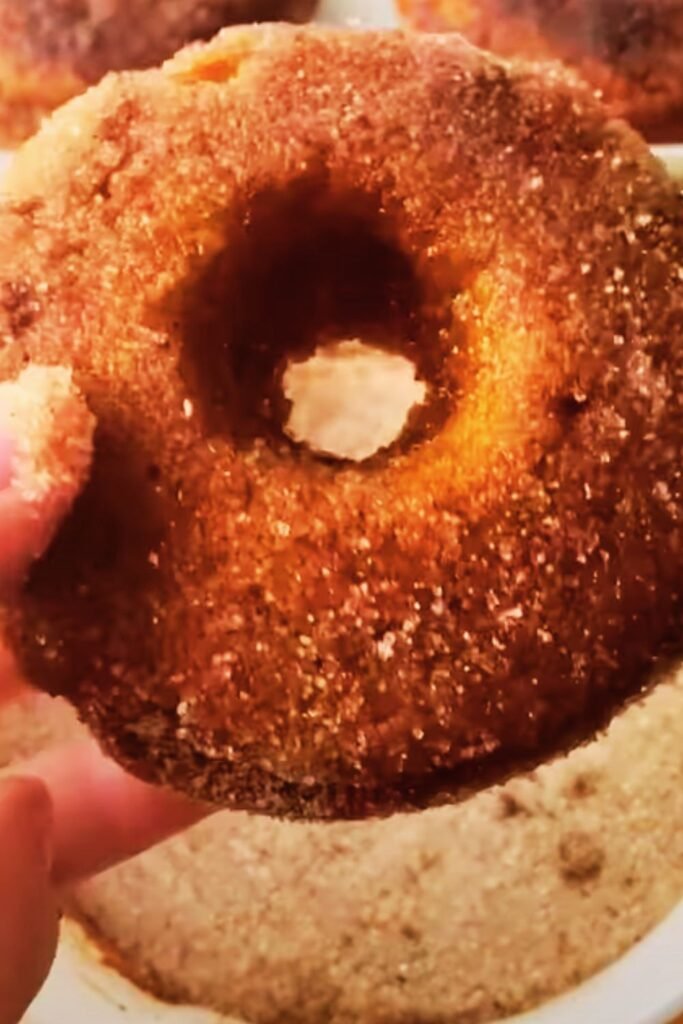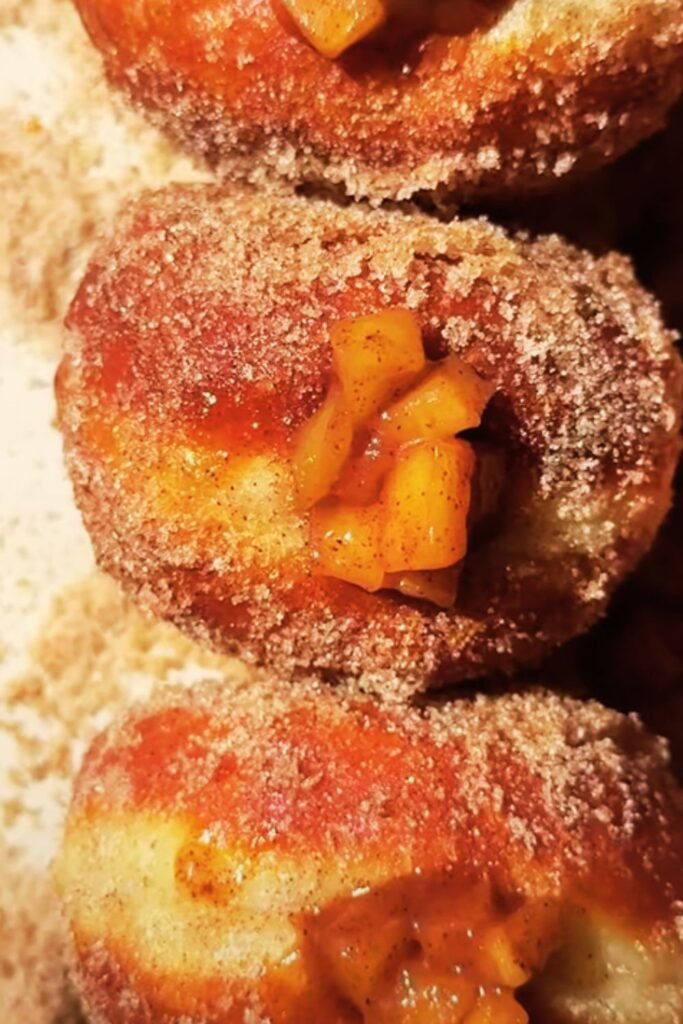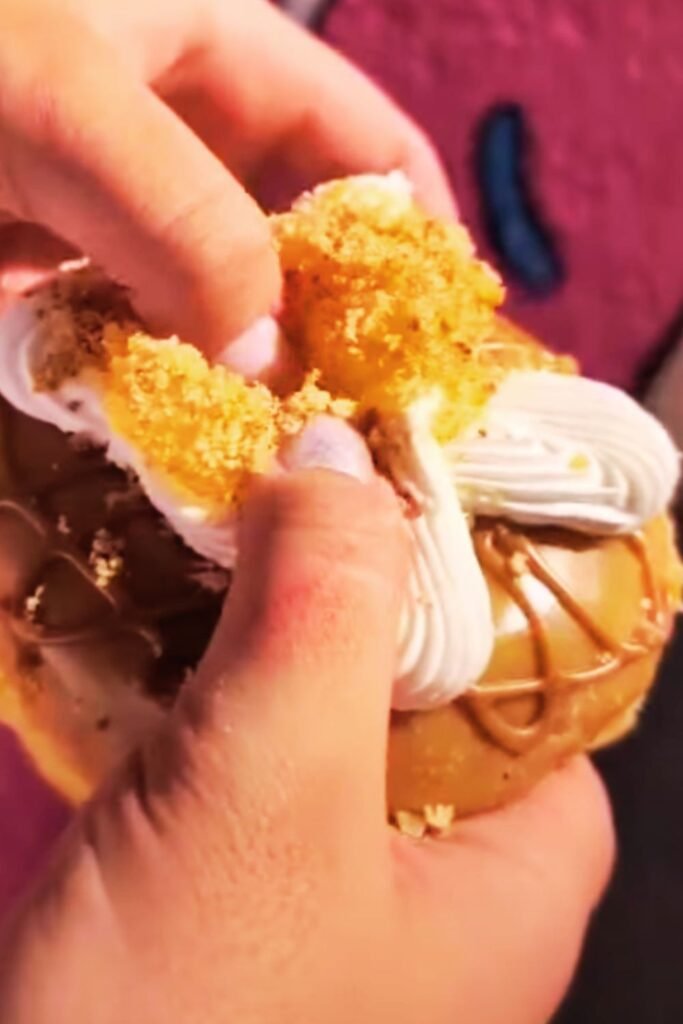There’s something magical about combining two beloved desserts into one irresistible creation. When I first experimented with apple pie doughnuts in my kitchen, I knew I’d stumbled upon something special. These golden, fluffy rings capture all the warm, comforting flavors of traditional apple pie while delivering the satisfying texture of a perfectly crafted doughnut.
The beauty of apple pie doughnuts lies in their versatility and the way they bring together the best of both worlds. Unlike regular doughnuts that rely solely on sweetness, these treats incorporate the complex flavors of cinnamon-spiced apples, creating a more sophisticated and memorable eating experience. I’ve been perfecting this recipe for years, and I’m excited to share every detail that makes these doughnuts truly exceptional.
Understanding Apple Pie Doughnuts
Yeasted Doughnuts: Traditional doughnuts made with yeast that create a light, airy texture through fermentation. The yeast provides the characteristic fluffy interior that perfectly complements the apple pie filling.
Apple Pie Filling: A mixture of diced apples, cinnamon, sugar, and spices that’s cooked until tender. This filling can be incorporated into the dough or used as a topping, depending on your preferred preparation method.
Cinnamon Sugar Coating: A classic finishing touch made from granulated sugar mixed with ground cinnamon. This coating adds texture and enhances the apple pie flavor profile.
Glaze Options: Various sweet coatings including vanilla glaze, caramel drizzle, or maple frosting that complement the apple and cinnamon flavors.
Essential Ingredients and Their Roles
The success of apple pie doughnuts depends heavily on using quality ingredients and understanding how each component contributes to the final product. I’ve learned through countless batches that small details make enormous differences in the outcome.
For the Doughnut Base
| Ingredient | Quantity | Purpose | Tips |
|---|---|---|---|
| All-purpose flour | 4 cups | Structure and texture | Use unbleached for better flavor |
| Active dry yeast | 2¼ teaspoons | Leavening agent | Test freshness in warm water |
| Granulated sugar | ½ cup | Sweetness and yeast food | Don’t reduce – affects texture |
| Whole milk | 1 cup | Moisture and richness | Room temperature works best |
| Unsalted butter | 4 tablespoons | Flavor and tenderness | Must be softened |
| Large eggs | 2 whole | Binding and richness | Room temperature preferred |
| Salt | 1 teaspoon | Flavor enhancement | Use fine sea salt |
| Vanilla extract | 2 teaspoons | Aromatic depth | Pure extract only |
For the Apple Pie Filling
| Ingredient | Quantity | Purpose | Variety Recommendations |
|---|---|---|---|
| Apples | 3 medium | Main flavor component | Granny Smith, Honeycrisp, or Braeburn |
| Brown sugar | ⅓ cup | Sweetness and caramel notes | Light brown preferred |
| Ground cinnamon | 2 teaspoons | Signature spice | Ceylon for subtle flavor |
| Nutmeg | ¼ teaspoon | Warm spice complexity | Freshly grated preferred |
| Cornstarch | 1 tablespoon | Thickening agent | Prevents soggy doughnuts |
| Lemon juice | 1 tablespoon | Prevents browning | Fresh squeezed recommended |
| Butter | 2 tablespoons | Richness and moisture | Unsalted only |
Step-by-Step Preparation Method
Creating perfect apple pie doughnuts requires patience and attention to detail. I’ve refined this process through years of experimentation, and each step serves a specific purpose in achieving the ideal texture and flavor.
Preparing the Apple Filling
The apple filling must be prepared first and allowed to cool completely before incorporating it into the doughnut process. This prevents the filling from making the dough too wet and ensures even distribution throughout.
I start by peeling and dicing the apples into small, uniform pieces – about ¼-inch cubes work perfectly. The size matters because larger pieces can create air pockets in the doughnuts, while smaller pieces integrate better into the dough structure.
In a medium saucepan over medium heat, I melt the butter and add the diced apples. The initial cooking phase takes about 3-4 minutes, just until the apples begin to soften slightly. Then I add the brown sugar, cinnamon, nutmeg, and cornstarch, stirring constantly to prevent burning.
The mixture needs to cook for another 5-7 minutes until the apples are tender but still hold their shape. The cornstarch will thicken the mixture, creating a jammy consistency that won’t leak out of the doughnuts during frying. I finish with lemon juice and remove from heat, allowing the filling to cool completely while I prepare the dough.
Creating the Doughnut Dough
The doughnut dough requires careful attention to temperature and timing. I begin by warming the milk to about 110°F – it should feel warm but not hot to the touch. In a small bowl, I dissolve the yeast in the warm milk with a pinch of sugar, letting it sit for about 5 minutes until it becomes foamy. This step confirms that my yeast is active and viable.
In a large mixing bowl, I combine the flour, remaining sugar, and salt. I create a well in the center and add the foamy yeast mixture, beaten eggs, melted butter, and vanilla extract. Using either a stand mixer with a dough hook or mixing by hand, I combine these ingredients until a soft dough forms.
The dough will be slightly sticky at first, which is exactly what I want. I knead it for about 8-10 minutes until it becomes smooth and elastic. The windowpane test works well here – I should be able to stretch a small piece of dough thin enough to see through without it tearing.
First Rise and Shaping
After kneading, I place the dough in a greased bowl, cover it with a damp cloth, and let it rise in a warm, draft-free location for about 1-1.5 hours, or until doubled in size. The first rise is crucial for developing flavor and texture.
Once risen, I gently punch down the dough and turn it out onto a lightly floured surface. Here’s where the apple filling gets incorporated. I roll the dough into a large rectangle, about ½-inch thick, and spread the cooled apple filling evenly across the surface, leaving a 1-inch border around the edges.
Rolling the dough tightly from one long side, I create a log shape, then use a sharp knife to cut it into 12 equal pieces. Each piece gets shaped into a doughnut by gently stretching the center to create a hole, then placing them on parchment-lined baking sheets for the second rise.

Frying Techniques and Temperature Control
Proper frying technique makes the difference between soggy, greasy doughnuts and perfectly golden, crispy ones. I use a heavy-bottomed pot or deep fryer with at least 3 inches of oil – vegetable oil or canola oil work best due to their high smoke points and neutral flavors.
Temperature Management
| Temperature Range | Result | Notes |
|---|---|---|
| 350-375°F | Perfect golden exterior | Ideal frying temperature |
| Below 350°F | Greasy, soggy texture | Oil too cool, absorbs into dough |
| Above 375°F | Burned outside, raw inside | Oil too hot, exterior cooks too quickly |
| 325°F | Oil temperature for glazing | If double-frying for extra crispness |
I maintain oil temperature using a digital thermometer, checking it frequently throughout the frying process. The temperature will drop when doughnuts are added, so I adjust the heat accordingly to maintain consistency.
Each doughnut fries for approximately 2-3 minutes per side. I look for a deep golden brown color and use a slotted spoon to turn them gently. The doughnuts should float to the surface almost immediately when the oil temperature is correct.
After frying, I transfer the doughnuts to a wire rack set over paper towels to drain excess oil. This prevents them from becoming soggy on the bottom while maintaining the crispy exterior.
Finishing Options and Glazes
The final step in creating exceptional apple pie doughnuts involves choosing the right finishing technique. I’ve experimented with numerous options over the years, and each provides a different experience.
Classic Cinnamon Sugar Coating
My go-to finishing method involves tossing the warm doughnuts in a mixture of granulated sugar and cinnamon. I use a ratio of 1 cup sugar to 2 tablespoons cinnamon, which provides the perfect balance of sweetness and spice.
The key is coating the doughnuts while they’re still warm – this helps the cinnamon sugar adhere properly and creates that characteristic sandy texture that contrasts beautifully with the soft interior.
Glazing Options
| Glaze Type | Base Ingredients | Flavor Profile | Application Method |
|---|---|---|---|
| Vanilla Glaze | Powdered sugar, milk, vanilla | Sweet and classic | Dip while warm |
| Caramel Glaze | Brown sugar, butter, cream | Rich and buttery | Drizzle when cooled |
| Maple Glaze | Maple syrup, powdered sugar | Autumn-inspired | Brush on surface |
| Apple Cider Glaze | Reduced cider, powdered sugar | Concentrated apple flavor | Dip and drain |

Storage and Freshness Tips
Apple pie doughnuts taste best when consumed within 24 hours of preparation, but proper storage can extend their enjoyment for several days. I’ve developed specific techniques for maintaining their quality over time.
For short-term storage (1-2 days), I place the doughnuts in an airtight container at room temperature. If they’ve been glazed, I separate layers with parchment paper to prevent sticking.
For longer storage, freezing works remarkably well. I freeze the doughnuts before glazing, wrapped individually in plastic wrap, then placed in freezer bags. They maintain quality for up to 3 months. To serve, I thaw them at room temperature and apply fresh glaze or cinnamon sugar.
Troubleshooting Common Issues
Through years of making these doughnuts, I’ve encountered and solved numerous common problems that can arise during the process.
Dense, Heavy Texture: Usually indicates over-kneaded dough or insufficient rising time. The dough should be handled gently after the first rise, and adequate time must be allowed for both rising periods.
Greasy Doughnuts: Most commonly caused by oil temperature that’s too low. The doughnuts absorb oil instead of developing a proper crust. Maintaining temperature between 350-375°F prevents this issue.
Uneven Cooking: Results from inconsistent doughnut thickness or overcrowding the fryer. I ensure even rolling and fry only 2-3 doughnuts at a time to maintain oil temperature.
Apple Filling Leakage: Occurs when the filling is too wet or the dough isn’t sealed properly. Cooling the filling completely and ensuring proper dough sealing prevents this problem.
Nutritional Considerations and Variations
While apple pie doughnuts are certainly an indulgent treat, understanding their nutritional profile helps in enjoying them as part of a balanced approach to eating.
Nutritional Information (Per Doughnut)
| Component | Amount | Daily Value % |
|---|---|---|
| Calories | 285 | 14% |
| Total Fat | 12g | 18% |
| Saturated Fat | 4g | 20% |
| Carbohydrates | 42g | 14% |
| Dietary Fiber | 2g | 8% |
| Sugars | 18g | – |
| Protein | 5g | 10% |
| Sodium | 180mg | 8% |
Healthier Modifications
I’ve successfully created lighter versions of these doughnuts using several modification techniques:
Baked Version: Using a doughnut pan and baking at 375°F for 12-15 minutes creates a lighter alternative with about 40% fewer calories.
Whole Wheat Integration: Substituting up to half the all-purpose flour with whole wheat pastry flour adds fiber and nutrients without significantly affecting texture.
Reduced Sugar Options: Using natural sweeteners like honey or pure maple syrup in the dough reduces processed sugar content while maintaining sweetness.
Air Fryer Method: Cooking at 350°F for 6-8 minutes creates a crispy exterior with minimal oil usage.

Serving Suggestions and Pairings
Apple pie doughnuts shine when served thoughtfully, and I’ve discovered numerous ways to elevate the experience beyond simply eating them plain.
For breakfast or brunch, I serve them alongside hot coffee or spiced chai tea. The warm spices complement the apple and cinnamon flavors beautifully. Fresh apple slices and a dollop of Greek yogurt create a more substantial breakfast option.
As a dessert, these doughnuts pair wonderfully with vanilla ice cream or fresh whipped cream. A drizzle of caramel sauce adds extra indulgence, while a sprinkle of chopped toasted pecans provides textural contrast.
For special occasions, I create a doughnut tower or arrange them on a tiered serving stand. This presentation works particularly well for fall gatherings, apple-picking parties, or casual dinner parties.
Seasonal Adaptations and Creative Variations
The basic apple pie doughnut recipe serves as an excellent foundation for seasonal variations throughout the year. I’ve developed several adaptations that maintain the core concept while introducing new flavors.
Pumpkin Apple Pie Doughnuts: Adding ½ cup pumpkin puree to the dough and incorporating pumpkin pie spice creates a perfect autumn variation.
Caramel Apple Version: Incorporating caramel pieces into the apple filling and finishing with caramel glaze intensifies the dessert-like qualities.
Cranberry Apple Combination: Adding dried cranberries to the apple filling provides tartness and beautiful color contrast.
Bourbon Barrel Inspiration: A splash of bourbon in the apple filling (alcohol cooks off) adds sophisticated depth for adult palates.
Professional Tips for Consistent Results
After making hundreds of batches, I’ve identified key factors that ensure consistent, professional-quality results every time.
Temperature control remains the most critical factor. I use an instant-read thermometer for both the oil and ingredient temperatures. Room temperature ingredients mix more easily and create smoother dough.
Timing the rises properly prevents over-proofed dough. I look for visual cues – the dough should double in size but not become overly puffy or start to collapse.
Quality ingredients make a noticeable difference. Using real vanilla extract, fresh spices, and good butter elevates the final product significantly.
Patience during the cooling process prevents soggy bottoms and allows flavors to develop fully. I resist the temptation to glaze or coat the doughnuts until they’ve cooled for at least 10 minutes.
Questions and Answers
Q: Can I make the dough ahead of time and fry later? After the first rise, you can refrigerate the dough for up to 24 hours. The cold fermentation actually improves flavor development. Just allow extra time for the shaped doughnuts to come to room temperature before frying.
Q: What’s the best oil for frying these doughnuts? I prefer neutral oils with high smoke points like canola or vegetable oil. Avoid olive oil as its flavor can overpower the delicate apple pie taste, and it has a lower smoke point that can cause burning.
Q: How can I tell when the oil is the right temperature without a thermometer? Drop a small piece of dough into the oil. If it sizzles immediately and rises to the surface within 2-3 seconds, the oil is ready. If it sinks and doesn’t sizzle much, the oil is too cool. If it browns instantly, it’s too hot.
Q: Can I use different apple varieties? Absolutely! I recommend firm apples that hold their shape when cooked. Granny Smith provides tartness, Honeycrisp adds sweetness, and Braeburn offers complex flavor. Avoid soft apples like Red Delicious as they become mushy.
Q: Why do my doughnuts sometimes turn out dense? Dense doughnuts usually result from too much flour, over-kneading, or insufficient rising time. Measure flour by spooning it into the cup rather than scooping, and ensure your yeast is fresh and active.
Q: How do I prevent the apple filling from making the dough soggy? Cook the apple filling until most moisture has evaporated and it reaches a jammy consistency. Cool it completely before using, and avoid overfilling the doughnuts. The cornstarch in the filling helps absorb excess moisture.
Q: Can these doughnuts be made gluten-free? Yes, though the texture will be different. Use a high-quality gluten-free flour blend designed for baking, and add 1 teaspoon of xanthan gum if your blend doesn’t contain it. The dough may be slightly more delicate to handle.
Q: What’s the secret to getting the perfect hole in the center? After shaping the doughnut, gently stretch the center hole to about 1.5 inches in diameter. It will shrink slightly during the second rise and frying. If the hole is too small, the center may not cook through properly.
Q: How do I store leftover apple filling? Refrigerate leftover filling for up to one week or freeze for up to three months. It makes an excellent topping for pancakes, oatmeal, or ice cream. You can also use it as a filling for turnovers or coffee cake.
Q: Can I bake these instead of frying? Yes! Use doughnut pans and bake at 375°F for 12-15 minutes until golden brown. The texture will be more cake-like than traditional fried doughnuts, but they’ll still be delicious with fewer calories.
Creating perfect apple pie doughnuts requires attention to detail, quality ingredients, and patience, but the results are incredibly rewarding. These treats capture the essence of comfort food while providing the satisfaction of homemade baking. Whether you’re serving them for a special breakfast, bringing them to a gathering, or simply treating yourself, they never fail to impress.
The combination of yeasted dough, spiced apple filling, and various finishing options creates endless possibilities for customization. I encourage you to experiment with different apple varieties, spice combinations, and glazing techniques to find your perfect version.
Remember that baking is both an art and a science. While following the recipe precisely yields consistent results, don’t be afraid to make small adjustments based on your preferences and local ingredients. The joy of creating something delicious from scratch, especially something as special as apple pie doughnuts, makes every step of the process worthwhile.